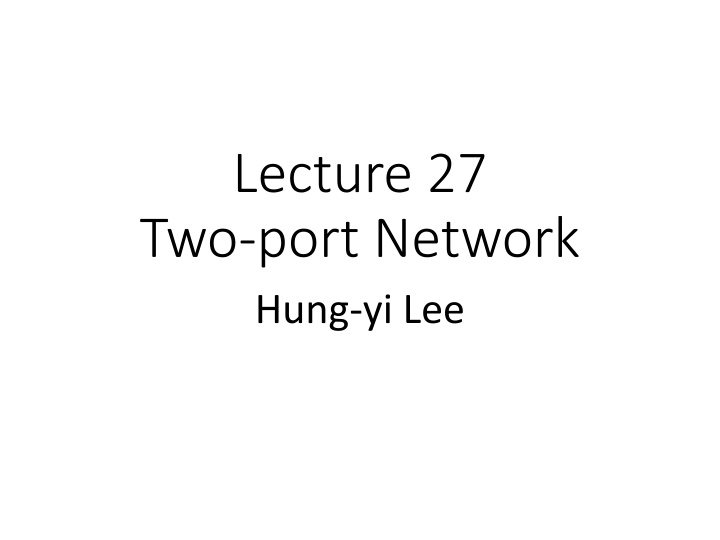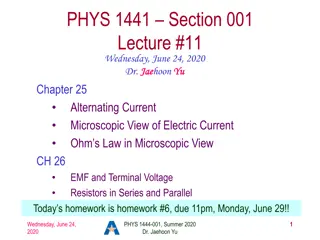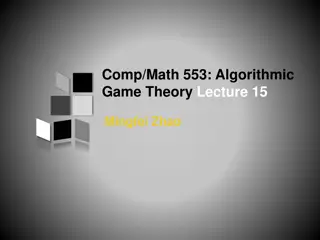
Two-Port Networks in Electrical Circuits
Explore the concept of two-port networks in electrical circuits, including analysis methods, parameters, and examples. Learn about the characteristics and superposition principle of two-port networks to enhance your understanding of circuit theory.
Download Presentation

Please find below an Image/Link to download the presentation.
The content on the website is provided AS IS for your information and personal use only. It may not be sold, licensed, or shared on other websites without obtaining consent from the author. If you encounter any issues during the download, it is possible that the publisher has removed the file from their server.
You are allowed to download the files provided on this website for personal or commercial use, subject to the condition that they are used lawfully. All files are the property of their respective owners.
The content on the website is provided AS IS for your information and personal use only. It may not be sold, licensed, or shared on other websites without obtaining consent from the author.
E N D
Presentation Transcript
Lecture 27 Two-port Network Hung-yi Lee
Reference Chapter 14.1, 14.2, 14.3 (out of the scope)
Two and Three Terminal Networks i Circuit + Two- Terminal Network v Circuit Three-Terminal Network - i Chapter 2 Chapter 4.6
Four Terminal Network i1 = i3 i2 = i4 Input port Output port 4 parameters: i1, v2, i2, v2 (E.g. Filter)
Two-Port Network Is it a two-port network? i12 i2 i1 i11 i2 i1 Is it a two-port network?
Note Two-port network can be expressed by the phasor notation. A two-port network contains no independent sources, although it may contain controlled sources.
i-v characteristics Z parameters: = + V I I z z 1 11 z 1 I 12 z 2 I = + V 2 21 1 22 2 V I z 1 1 = V I 2 2 z z z 11 12 = z z 21 22
= + V I I z z 1 11 z 1 I 12 z 2 I Z parameters = + V 2 21 1 22 2 Superposition Principle: Any current (or voltage) for an element is the weighted sum of the voltage (or current) of the sources.
Z parameters How to find the Z parameters? = + V I I z z 1 11 z 1 I 12 z 2 I = + V 2 21 1 22 2 I1= 0 Set = = V I V I z z 12 1 2 22 2 2 I2= 0 Set = = V I V I z z 21 2 1 11 1 1
Z parameters Example 14.1 = + V I I z z 1 11 z 1 I 12 z 2 I = + V 2 21 1 22 2 I1= 0 Set R2 + R2 V sC R + = = = 1 V I z = I 12 1 2 2 2R 1 sC + R 2R 1 2 R 1 sC sC ( ) + + sCR2 R R 1 sC R ( ) = V I z = + = = || R 1 R sC 22 2 2 + + 2R 1 sC 2sCR 1
Z parameters Example 14.1 = + V I I z z 1 11 z 1 I 12 z 2 I = + V 2 21 1 22 2 I2= Find z11and z21 0 Set R2 sC z = = z 12 + 21 2 R 1 sC symmetric + sCR2 R = z z = 22 11 + 2sCR 1
Equivalent Two Port Network = + V I I z z 1 11 z 1 I 12 z 2 I = + V 2 21 1 22 2 Two Impedances, Two controlled sources Three Impedances, One controlled source
Equivalent Two Port Network Tee Network z z z 11 12 = z z 21 22 = = I1= V I z = = Z + V I z 0 c Z Z Set 22 2 2 12 1 2 b c = = = = Z + V I V I z z c Z Z I2= 0 Set 21 2 1 11 1 1 a c + Z Z Z Z z Reciprocal Network a c c = + Z Z c b c
Equivalent Two Port Network Tee Network = z + Z Z Z Z a c c + Z Z c b c Reciprocal Network z z z z z z z 22 11 11 z = z z 22
Equivalent Two Port Network = + = + V I I V I I z z z z 1 11 z 1 I 12 z 2 I 1 11 z 1 12 z 2 ( )1 I = + = + + V V I I z z 2 21 1 22 2 2 12 1 22 2 21 12 ( )1 I z z 21 12 z z z z 22 12 11 12 z 12
Other kinds of Parameters y parameters: Z parameters: I V V I y z 1 1 1 1 = = I V V I 2 2 2 2 = z y 1 The y parameters does not always exist. [z] is not always invertible.
4 2 C 6 kinds of Parameters z parameters: h parameters: T parameters: V I V I V V z h T 1 1 1 1 1 2 = = = V I I V I I 2 2 2 2 1 2 y parameters: g parameters: t parameters: I V I V V V g t y 1 1 2 1 1 1 = = = I V V I I I 2 2 2 2 2 1 Be careful!
T/t Parameters V V V V t T 2 1 1 2 = = I I I I 2 1 1 2 T/t for transmission 1I 2I For T For t Parameters Parameters
Connecting the Two-port Networks Parallel Connection: Series Connection: Cascade Connection:
Parallel Connection I I 2a 1a + + V I a y y 1 a 1 = V V 1 2 a V I 2 a 2 I I 2b 1b + + b y V I y V 1 b 1 = V 1 2 b V I 2 b 2
Parallel Connection I V I I y 1 a 1 = 2a 1a a V I 2 a 2 a y 1I 2I V I y 1 b 1 = + + b V I 2 b 2 V V I I 1 2 2b 1b I I I 1 1 1 a b = + V I I b y I 2 y 2 2 a b y 1 = + a b V 2 V I y y b y y 1 1 = + = par par a V I 2 2
Parallel Connection - Note Parallel two two-port network can break the port condition 5 + + V V 5 . 2 10 1 2 + + 10 V 5V + + 2 A 2 A 5 . 2 V V y y b y 2 1 = + 0 A 0 A par a 5 . 2
Series Connection 2I 1I + + a z V I z 1 1 a = V V 1a 2a a V I 2 2 a 2I 1I + + b z I V z 1 1 b = V V 1b 2b b I V 2 2 b
Series Connection V I z 1 1 a = a V I 2 2 a 2I 1I I V z 1 1 b = + + + + a z b I V 2 2 b V V 1a 2a V V V 1 1 1 a b = + 2I V 1I V 1 V V V 2 2 2 2 a b + + b z I z z V V 1 = + 1b 2b a b I 2 Not always true because parallel connection may also break the port condition z z b z = + ser a
Cascade connection V V V V T T 1 2 b = 2 1 a = b aI I I I 1 2 b 2 1 a V V V The overall T parameters equals the product of the individual T parameters. T a Tcas 1 2 = 2 = T b I I I 1 2 2
Cascade connection + V V V out in x 1 1 V V V V V sC sC out x out x out = = 1 2 1 1 V V V V V + + R R in x in in x 1 2 sC sC 1 2 V 1 out = ( ) + + + + 2 V 1 R R R s C C R C s C C R 1 1 2 2 1 2 1 2 1 2 in
V 1 out = ( ) + + + + 2 V 1 R R R s C C R C s C C R 1 1 2 2 1 2 1 2 1 2 in Cascade connection in I = I 0 out V V in out b T a T out V V A B A B V a T in = out = T b I I C D C ) ) V D 0 in out ( ( V V + A A C A B V A B V 1 out = out out = = + + C A C C D C D V A A B C out out in
Cascade connection 1I V V 2I V A B T 1 2 2 = = V = I I + + I C D 1 2 2 V V + V I A B 1 2 1 2 2 = + I V I C D 1 2 2 I V + R 1 sC sC I2= 0 1 1 = = = = = sC + C 1 1 sC A R1 1 1 1 V V 1 2 2 1 V2= 0 I V 1 1 D = B= = = R 1 1 I I 2 2
V 1 out = ( ) + + + + 2 V 1 R R R s C C R C s C C R 1 1 2 2 1 2 1 2 1 2 in Cascade connection in I = I 0 out V V in out b T a T + R sC 1 A B sC R Ta 1 1 1 = = V 1 C D 1 out 1 = + V A A B C + R sC 1 A B sC R Tb in 2 2 2 = = 1 C D 2
This Friday 2011 ( )
Acknowledgement (b02)






















